VMware SD-WAN Troubleshoot 5V0-41.20 Exam Questions
If you decide to apply for VMware SD-WAN Troubleshoot 2021 certification, you need to be required to recognize the importance of 5V0-41.20 VMware SD-WAN Troubleshoot Exam. To help you complete VMware SD-WAN Troubleshoot 2021 certification, PassQuestion provides you with VMware SD-WAN Troubleshoot 5V0-41.20 Exam Questions to pass 5V0-41.20 VMware SD-WAN Troubleshoot Exam.PassQuestion team collected 38 practice exam questions and answers based on VMware 5V0-41.20 exam topics and objectives, which are valid and useful to guarantee your success in VMware certification 5V0-41.20 exam.
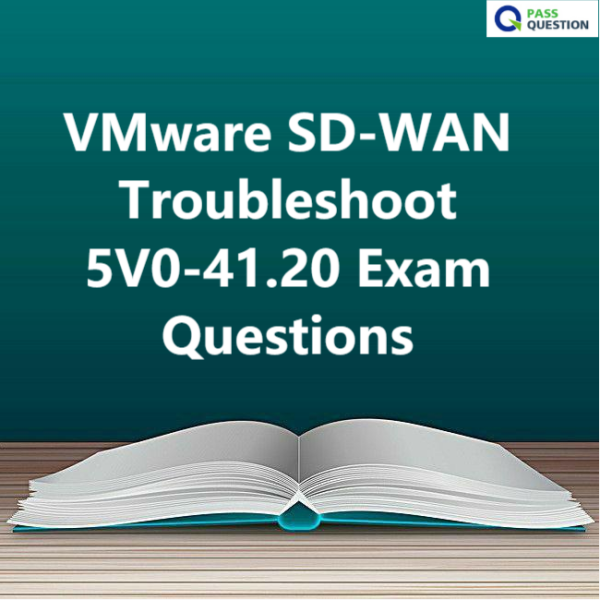
VMware SD-WAN Troubleshoot 5V0-41.20 Exam Description
The VMware SD-WAN Troubleshoot badge is intended for individuals who are Technical Support Engineers at Level 1 or Level 2 and are a part of a Managed Service Provider. It is also intended for general customers who already have a solid understanding of deploying and designing the VMware SD-WAN solution and, need to be able to leverage diagnostic capabilities of the solution to do immediate troubleshooting of issues.
The VMware SD-WAN Troubleshoot(5V0-41.20) exam which leads to the VMware SD-WAN Troubleshoot 2021 badge is a 36-item exam with a passing score of 300 using a scales method. Candidates given an appointment of 95 minutes which include five-minute seating time. Actual exam time is 90 minutes.
Exam Information
Exam Number: 5V0-41.20
Associated Certification: VMware SD-WAN Troubleshoot 2021
Duration: 90 Minutes
Number of Questions: 36
Passing Score: 300
Exam Language: English
Format: Single and Multiple Choice, Proctored
5V0-41.20 Exam Content
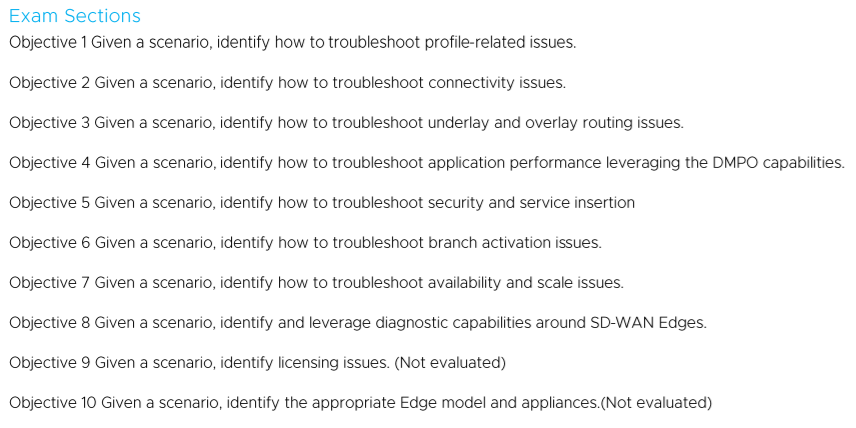
View Online VMware SD-WAN Troubleshoot 5V0-41.20 Free Questions
Scenario: 1
A network administrator is tasked with enabling SD-WAN at three branch locations, A topology has been provided for reference. For each site, the administrator is having issues bringing edges online, as another administrator has gone ahead and created a configuration ahead of time. The organization has several branch sites. One is an Internet-only site and two are Hybrid locations with both internet and MPLS. The last location is MPLS only. There are hub data center in this environment as well. Please refer to the topology.
Exhibit.
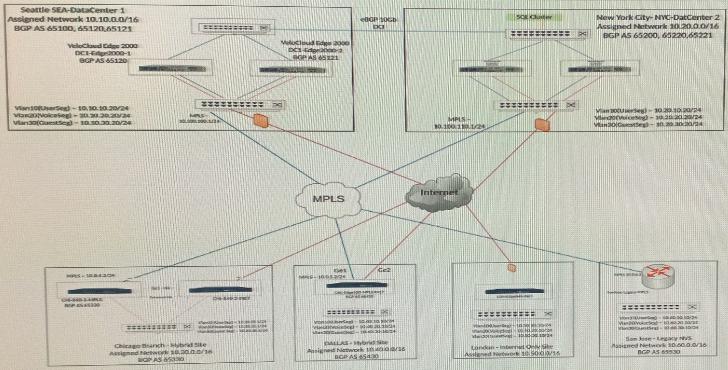
One of the Edges at the Chicago site is unable to activate. The Edge has a red LED. What is the next troubleshooting step?
A. If the Edge is connected to its HA peer, determine if there is a link-light on the HA peer-link.
B. If the Edge is connected to the MPLS circuit, determine if the Hub is advertising gateway routes.
C. If the Edge is connected to the MPLS circuit which does not have DHCP, determine if there is a static IP configuration that needs to be applied upon activation.
D. If the Edge is connected to its HA peer, determine if underlay BGP peering is present between the two Edges.
Answer : B
Scenario: 2
After completing the branch activation for all required branches, the network administrator attempts to test connectivity between the various branches and between hubs and branches. The administrator notices a lack of connectivity despite being certain that configurations have been complete. The administrator also observed that several users are reporting intermittent connectivity to some of the some applications they are accessing. Other users are reporting no access to these applications. Other users at some of the branches claim they cannot get to certain public resources. The administrator wants to ensure that all sites can talk to each other and all resources are accessible.
Exhibit.
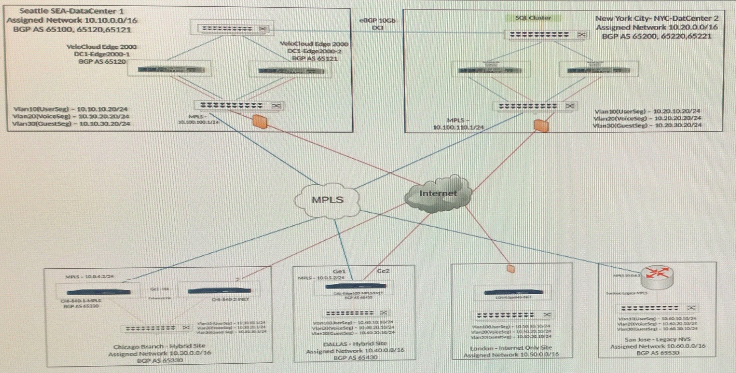
A technician has added Edges to an East Coast Profile. These Edges are not able to communicate via dynamic tunnels to Edges in the West_Coast profile. The technician has noticed that some Edges are able to establish dynamic tunnels.
What could be preventing Edges from being able to establish dynamic tunnels?
A. The profiles are not configured to allow dynamic branch to branch VPNs.
B. The profiles are configured to only allow dynamic branch to branch for Edges within the same profile.
C. None of the existing profiles have Cloud VPN enabled thus preventing dynamic tunnels.
D. Neither profile has been configured to utilize cloud gateways.
Answer : A
Scenario 3:
After resolving numerous connectivity issues throughout the various branch sites, connectivity between applications and users is finally present. The network administrator is informed that during certain tests, applications are not performing as they are expected to. Users report that call quality has not fully improved and that some of their calls either drop or have poor voice quality where the conversation is breaking up. Other users are noticing that file transfers are slower than expect. A group of users from a few sites have reported slowness in accessing internal and external applications.
Exhibit.
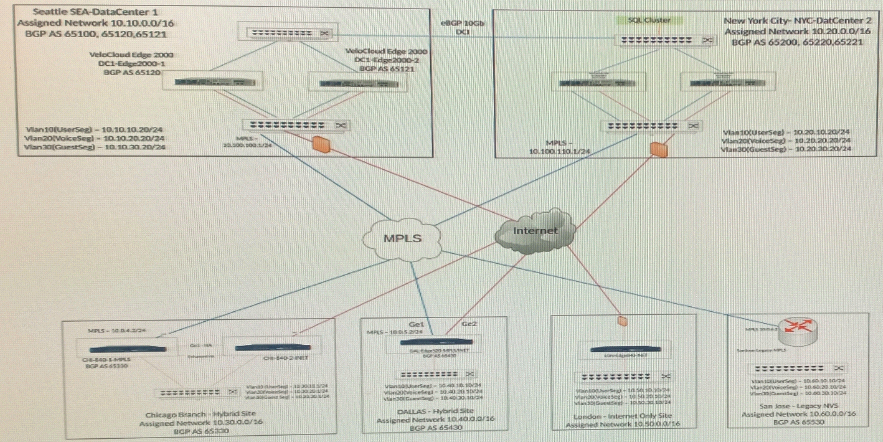
A network engineer is configuring an Internet Backhaul Policy for the Chicago Branch to utilize NY's hub as a much better source for Internet for certain SaaS applications. For an unknown reason, the network engineer is not able to select the hubs in the Internet Backhaul Policy.
What could be the reason?
A. The Dynamic Branch to Branch has not been enabled.
B. The hub is not configured with the proper IP address.
C. Dynamic Branch to Branch using gateways has not been enabled.
D. The Edge's profile does not include Backhaul hubs as an option.
Answer : C
- TOP 50 Exam Questions
-
Exam
All copyrights reserved 2025 PassQuestion NETWORK CO.,LIMITED. All Rights Reserved.

